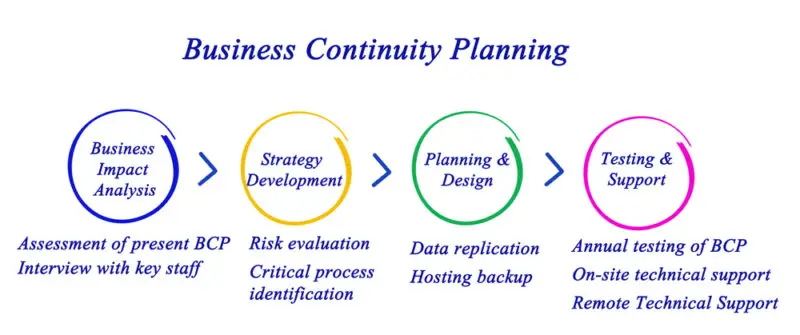A Business Continuity Plan (BCP) ensures that a company can continue operating during and after a disaster or disruption. Key components of a BCP typically include:
- Risk Assessment and Business Impact Analysis: This involves identifying potential risks and assessing how they could affect critical business functions. (MoserIT)
- Recovery Strategies include planning for IT disaster recovery, data backups, and maintaining critical operations with minimal downtime. It’s essential to have a strategy for each critical business function, such as payroll, revenue operations, and information security. (Zerto)
- Plan Development: This comprises the actual creation of the BCP, detailing the steps to take during and after an incident, including emergency response and crisis communication plans. It also outlines roles and responsibilities for the business continuity team and other stakeholders. (LinkedIn)
- Testing and Exercises: Regular testing of the BCP is crucial to ensure that the plan is effective and that team members are familiar with their roles in an emergency. (CIO)
- Plan Maintenance: The BCP should be regularly reviewed and updated to reflect changes in the business environment, personnel, or technology. (TechTarget)
These components ensure a business is prepared to continue critical functions and recover from disruptions as efficiently as possible.
In today’s dynamic and unpredictable business landscape, organizations must have a robust Business Continuity Plan (BCP).
A well-crafted BCP serves as a blueprint, outlining the necessary steps and strategies to ensure the continuity of critical business operations in the face of unforeseen disruptions.

But what exactly should be included in a BCP? How can businesses effectively identify and mitigate potential risks and vulnerabilities?.
In this discussion, we will delve into the key components of a comprehensive BCP, from assessing risks and vulnerabilities to establishing a dedicated business continuity team and developing recovery strategies.
By exploring these crucial elements, we will gain valuable insights into the essential ingredients of a resilient and proactive approach to business continuity.
Key Takeaways
- A Business Continuity Plan (BCP) is a comprehensive strategy that ensures continuity in the face of unexpected disruptions or disasters.
- Assessing risks and vulnerabilities is critical for developing a robust BCP, including identifying potential threats and their impact on critical functions.
- Conducting a Business Impact Analysis (BIA) helps identify and prioritize critical business processes, assess potential risks, and determine the financial impact of disruptions.
- Establishing a dedicated Business Continuity Team with defined roles and responsibilities is essential for effective contingency planning and minimizing disruptions.
Definition of a Business Continuity Plan (BCP)
A Business Continuity Plan (BCP) is a comprehensive strategy that outlines the steps and procedures an organization must take to ensure its continuity in the face of unexpected disruptions or disasters.
It is essential for businesses to have a BCP in place to minimize downtime, protect assets, and maintain operations during unforeseen events such as natural disasters, cyber-attacks, or pandemics.
Importance of having a BCP
Implementing a robust and comprehensive Business Continuity Plan (BCP) is essential for any organization’s long-term success and resilience.
A BCP outlines the steps to be taken in emergencies or potential threats, ensuring that critical business functions can continue without major disruptions.
By identifying potential threats and assessing their impact on critical functions, a BCP helps allocate resources effectively and plan for efficient recovery.
It also provides a framework to guide employees during emergencies, ensuring their safety and minimizing downtime.
A well-designed BCP safeguards the organization’s reputation and instills confidence among stakeholders and customers.
It is an indispensable tool in business continuity planning, enabling organizations to adapt to unforeseen challenges and maintain operational efficiency.
Assessing Risks and Vulnerabilities
Assessing risks and vulnerabilities is a critical step in developing a robust business continuity plan.
This process involves identifying potential threats that could disrupt business operations and analyzing their potential impact.
Identifying potential threats
Identifying potential threats and assessing risks and vulnerabilities is critical in developing a comprehensive Business Continuity Plan.
It is essential for businesses to be proactive in identifying potential threats that could disrupt their operations and impact their customers.
Here are five key areas to consider when identifying potential threats:
- Natural disasters: Assess the risks associated with natural disasters such as hurricanes, earthquakes, floods, or wildfires, and evaluate their potential impact on business operations.
- Technology failures: Consider the potential risks associated with technology failures, such as power outages, cyber-attacks, or data breaches, and develop strategies to mitigate these risks.
- Supply chain disruptions: Identify potential risks in the supply chain that could impact the availability of key resources or materials needed for business operations.
- Human factors: Evaluate potential threats from human factors, such as employee errors, labor disputes, or internal sabotage.
- Regulatory changes: Consider the potential impact of regulatory changes on business operations and develop strategies to adapt.
Analyzing impact on business operations
To effectively analyze the impact on business operations, it is crucial to thoroughly assess the risks and vulnerabilities that could disrupt the organization’s smooth functioning.
This step is integral to the business continuity planning process and helps identify critical processes and develop appropriate recovery strategies.
A comprehensive assessment involves evaluating various aspects, such as potential threats, business disruption scenarios, and recovery time objectives.
By conducting a thorough analysis, organizations can prioritize their resources and focus on key components essential for business continuity.
To assist in the assessment process, a three-column, three-row table can be used to categorize risks, vulnerabilities, and their potential impact on business processes.
This analysis serves as a foundation for developing robust business continuity plans and effective risk management strategies to ensure the organization’s continuous operation.

Conducting a business impact analysis (BIA)
Conducting a business impact analysis (BIA) is crucial in assessing the risks and vulnerabilities that could disrupt business operations.
It allows organizations to identify and prioritize critical business processes and understand their financial impact during a disruption.
Here are five critical components of conducting a BIA:
- Identify critical business processes: Determine the key essential functions and activities for the organization’s survival and success.
- Assess potential risks: Identify threats and vulnerabilities that could impact these critical processes, such as natural disasters, cyber-attacks, or supply chain disruptions.
- Determine financial impact: Evaluate the potential financial consequences of disrupting these critical processes, including lost revenue, increased expenses, and reputational damage.
- Engage the business continuity team: Involve key stakeholders from different departments to ensure a comprehensive analysis and gain diverse perspectives.
- Develop contingency plans: Based on the BIA findings, create backup plans and strategies to mitigate the identified risks and minimize the impact on critical business processes.
Identifying Critical Business Functions
In order to create an effective business continuity plan, it is crucial to identify the critical functions essential for the organization’s operations.
This involves determining which processes are vital for the continued functioning of the business and understanding the dependencies between different functions.
Determining essential processes
When determining essential processes for a business continuity plan, it is crucial to identify the critical business functions that are integral to the organization’s operations and overall success.
These functions are the key personnel, components, and operations that need to be prioritized and protected in the event of an incident or emergency.
To determine these essential functions, organizations should consider the following:
- Conduct a comprehensive risk assessment to identify potential threats and vulnerabilities.
- Evaluate the impact of each potential incident on different business operations.
- Identify the personnel and resources required to maintain critical functions during an incident.
- Prioritize critical business operations based on their importance to the organization’s overall success.
- Develop a proactive approach and integrate these essential functions into the business continuity plan template and strategy.
Assessing dependencies between functions
Organizations must assess the dependencies between different functions within their operations to effectively identify critical business functions. This involves understanding how each function relies on other functions to operate smoothly.
For example, the customer service department may depend on the availability of phones and a technology infrastructure to handle customer inquiries.
On the other hand, human resources may rely on key employees to ensure the smooth running of daily operations.
By assessing these dependencies, organizations can prioritize their resources and develop backup strategies to mitigate the impact of unexpected events. This is crucial as any disruption in critical functions can lead to a loss of revenue and reputational damage.
Establishing a Business Continuity Team
When establishing a business continuity team, there are two key points to consider: forming a dedicated team and defining roles and responsibilities.
The success of a business continuity plan relies heavily on having a team of individuals who are committed to ensuring the organization’s resilience in the face of disruptions.
Forming a dedicated team
In order to effectively establish a Business Continuity Team, it is crucial to assemble a dedicated group of individuals who possess the necessary skills and expertise to ensure the continuity of business operations.
Here are some key factors to consider when forming this team:
- Disaster Recovery Planning: Team members should have a deep understanding of disaster recovery planning and the ability to develop effective strategies for mitigating potential risks.
- Recovery Systems: They should be familiar with various recovery systems and possess the technical knowledge to implement them seamlessly.
- Emergency Services: The team should have connections with emergency service providers to ensure a swift response in times of crisis.
- Senior Management: It is important to involve senior management in the team to ensure that decisions align with the overall business objectives.
- Business Continuity Planning Software: Utilizing business continuity planning software can help the team streamline their efforts and enhance their effectiveness.
Defining roles and responsibilities
As the Business Continuity Team takes shape, the next crucial step is to clearly define the roles and responsibilities of each team member to ensure a smooth and effective establishment of the business continuity plan.
This step is essential for effective contingency planning and minimizing the disruption of business functions in case of unexpected events.
Defining roles and responsibilities helps in making decisions about recovery priorities and assigning tasks to the appropriate individuals or teams.
It also facilitates the development of communication plans to ensure effective coordination and collaboration during a crisis. To provide a clear understanding, here is a table summarizing the key roles and responsibilities within the Business Continuity Team:
| Role | Responsibilities |
|---|---|
| Team Leader | Overall coordination and decision-making |
| Business Function | Identify and prioritize critical operations |
| Coordinator | Liaison with key business functions |
| Communication | Develop and implement communication plans |
| Recovery Coordinator | Coordinate recovery efforts with business partners |
| IT Coordinator | Liaison with IT teams and third-party providers |
Developing Recovery Strategies
When developing recovery strategies for a business continuity plan, it is essential to consider different options for recovering operations in the event of a disruption.
This involves evaluating the costs and benefits associated with each option to determine the most effective and efficient approach.
Considering different recovery options
Different recovery options must be carefully considered when developing a comprehensive business continuity plan. The recovery options chosen should align with the goals and objectives of the organization, as well as the potential risks and impacts identified during the business continuity analysis.
Here are five key recovery options to consider:
- Disaster Recovery: Implementing a plan focused on restoring critical IT systems and infrastructure after a major disruption.
- Proactive Strategies: Develop preventative measures and proactive actions to minimize the impact of disruptive incidents.
- Emergency Management Plan: Establishing protocols and procedures to respond to emergencies and ensure the safety of employees and stakeholders.
- Business Continuity Impact Analysis: Conduct a thorough assessment of potential impacts on critical functions and processes, and develop strategies to mitigate these impacts.
- Business Continuity Event: Planning for the recovery of business operations in the event of a business continuity event.
Evaluating costs and benefits
To ensure the effectiveness of the business continuity plan, it is essential to thoroughly evaluate the costs and benefits associated with developing recovery strategies.
Evaluating costs and benefits allows organizations to make informed decisions about the most effective and efficient ways to mitigate potential losses and reduce business interruption.
By investing in a comprehensive recovery plan, businesses can enhance their business resilience and minimize the impact of disruptions.
Disaster recovery strategies should be evaluated based on their ability to protect critical resources, maintain customer satisfaction and confidence, and minimize business risk.

While there may be initial costs associated with implementing these strategies, the long-term benefits far outweigh the expenses.
Evaluating costs and benefits is crucial for organizations to ensure the continuity of their operations and safeguard their future success.
Conclusion
In conclusion, a business continuity plan is a crucial component for organizations to prepare for and respond to potential disruptions.
By assessing risks and vulnerabilities, identifying critical business functions, and establishing a dedicated team, businesses can develop effective recovery strategies.
This proactive approach ensures the continuity of operations and minimizes the impact of disruptions on the organization.
With a well-defined and comprehensive business continuity plan in place, businesses can navigate through unexpected challenges with resilience and minimize potential losses.

Chris Ekai is a Risk Management expert with over 10 years of experience in the field. He has a Master’s(MSc) degree in Risk Management from University of Portsmouth and is a CPA and Finance professional. He currently works as a Content Manager at Risk Publishing, writing about Enterprise Risk Management, Business Continuity Management and Project Management.


